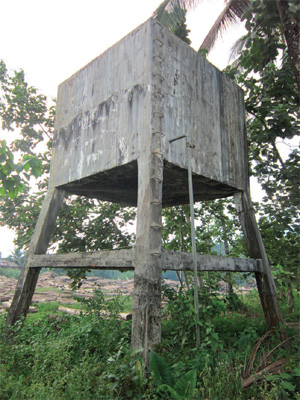Climate and environmentally smart disaster mitigation measures
Climate and environmentally smart disaster mitigation measures
Partners for Resilience (PfR) member Analyn E. Bernal, Agri-Aqua Development Coalition-Mindanao, reflects on new pathways for building resilience in the Philippines as part of a CDKN supported series of voices from the field.
Talacogon is situated in the center of the Agusan River Basin, one of the 18 major river basins in the Philippines. Portions of the town lie within the Agusan marsh and peat lands, which serve as a catchment for flood waters from several upstream provinces. Every year, for about three months, many Talacogon villages are affected by floods several meters high, which in recent years have grown increasingly hazardous due to changes in duration and timing. Another problem is the deterioration of water quality. For the past two years, typhoons have also affected Talacogon and other areas of Mindanao which are not in the usual typhoon paths.
Because of this changing situation, the community has determined, through PfR projects, to implement small-scale mitigation measures. These measures take into consideration the wider ecosystem that provides services and increases livelihood resilience.
The PfR project contributed in developing environmentally sustainable mitigation measures by improving existing community risk assessment tools that incorporate questions on climate change and ecosystem information. It also used the ecosystem-smart (eco-smart) criteria developed by Wetlands International to check whether proposed mitigation measures were environmentally sustainable. The proposals were finalized during CARE’s project cycle management training.
Greening the river banks
The community risk assessments were facilitated by the local PfR partner Agri-Aqua Development Coalition-Mindanao (AADC). The assessment results have shown that riverbank erosion greatly contributes to water pollution of the Agusan River and consequently the deteriorating quality of its water. Residents have pointed out how diverse trees and plants that used to line the riverbanks have greatly diminished because of erosion. Addressing this situation, Pascual Asis, a member of the village council of La Flora, says ‘We will plant trees along the riverbanks to lessen erosion and protect the banks from the strong current of floodwaters.’
Community members have pointed out that they should plant trees and use species endemic to the area to ensure a high survival rate. The PfR project will provide inputs like seedlings and training to community members about general ecosystem services management, and specifically about the technical elements of this mitigation measure. The PfR partner will also ensure a linkage with the local partner, Caraga State University, as well as the government’s Department of Environment and Natural Resources.
In Barangay (village) La Flora, forest cover of areas around the Lake Manabihid as well as several other lakes has significantly decreased in the past decades due to logging activities. This has resulted in increasingly rare sightings of many animal and bird species in the area. Examples are kalaw (Rufous hornbill), parrot, owl, monkey, and a variety of fish species Erosion is damaging the Agusan River. Experiences from Indonesia and Philippines 9 in surrounding water bodies.
While the logging industry provides income to residents, it has had a negative impact on their sources of food. And since fish are getting harder to catch, some villagers have resorted to electro fishing, the use of electricity through two electrodes to stun fish. This further intensifies the problem by damaging the fish population, stunning or killing even the smaller ones and scaring away the fish.
The reforestation activity is in line with larger reforestation efforts like the national greening program of the Department of Environment and Natural Resources and the local government unit, both aiming to increase the forest cover of the Rufous (Philippine) hornbill, locally known as kalaw, is a species endemic to Mindanao. municipality. These activities will not only benefit the municipality, but also other areas downstream.
Reviving the water source
In addition to these efforts, the risk assessment conducted by the PfR team pointed out the need to rehabilitate a deforested water shed in Barangay San Nicolas. This intervention will secure a continuous water supply of good quality for some 2,300 residents.
This watershed reforestation effort will complement another small-scale mitigation activity, the repair of water system in the same village. The pipe was washed away by the strong winds of Typhoon Washi in 2011 and has not been repaired since then. The tree where the pipe
[caption id="attachment_35496" align="alignright" width="205"] Rufous (Philippine) hornbill, locally known as kalaw, is a species endemic to Mindanao.[/caption]
Rufous (Philippine) hornbill, locally known as kalaw, is a species endemic to Mindanao.[/caption]
crossing the Agusan River used to perch also fell and only the stump remains.
Jose Guerrero, a village councillor and Project Management Team leader for the water system repair, explains: ‘The pipes will be placed on the same site, but instead of just putting it on a tree branch, concrete posts will be built to hold the pipes a few meters from the tree stump, so that it will not be destroyed easily by strong winds or river current.’
Since the water pipe was damaged, residents have had to fetch water from a neighboring barangay and transportation costs became
more expensive than the water itself. People harvested rainwater as much as possible, but when there is no rain, or if they do not have enough money to buy water, some fetch water from unprotected springs or the murky Agusan River itself, which they use for cooking and drinking.
Leaders and active community members know that restoring the water system is of utmost importance, and that accessing safe water is essential to safeguard health, sanitation and hygiene.
PfR supports this activity by providing construction materials for rehabilitation. To ensure quality intervention, PfR will provide technical assistance by giving an orientation to community members who help in the rehabilitation efforts.
Going organic
Another contributing factor to the pollution of Agusan River and other bodies of water in the area was identified in the PfR risk assessment as the widespread use of chemical fertilizers and pesticides by farms and plantations. Aware of this through climate- and eco-smart DRR training, communities have begun to cultivate rice, corn and vegetables organically.
Farming is the primary means of livelihood of most residents. There have been attempts by the women’s organizations to promote organic farming, which will be strengthened with efforts under PfR. With organic farming, yields will be lower than those produced using chemical fertilizer, but the costs of inputs will also be less. In the long run, this will influence farming practices of other areas and lessen chemical pollution of the river and its tributaries. To help the community go organic, PfR provides seeds that can resist the fluctuations of changing seasons, as well as training in organic farming. During PfR’s mid-term review, the farmers’ experiences during erratic seasons highlighted the need to include seasonal forecasts for sharing with farmers.
One of the difficulties after the rainy season is access to seeds and seedlings for planting. Because many farmers do not have enough money for inputs, lower input costs through organic practices will help lessen their expenses.
In addition, floating seedling nurseries will be established so that when flood waters subside, seedlings will be readily available for planting. This idea was inspired by a women’s organization as they practice setting up floating gardens with medicinal plants that are particularly useful during the flood season.
Moving forward
[caption id="attachment_35497" align="alignleft" width="225"] A water reservoir in Barangay San Nicolas.[/caption]
A water reservoir in Barangay San Nicolas.[/caption]
Small-scale mitigation activities are aimed at addressing the vulnerabilities of the communities and reducing the adverse impacts of hazards and possible disasters. These activities were identified by community members based on the result of community risk assessments, both of which were participatory and undertaken by community members themselves. Use of the integrated approach of climate and eco-smart DRR has definitely shaped the way the communities analyze their risk and subsequently the drawing-up of risk reduction measures.
The importance of a sound risk assessment is essential to successful implementation of climate- and eco-smart DRR training. It is only with a correct analysis that appropriate and effective risk reduction measures can be designed and an effective contingency plan formulated.
The PfR project also encourages communities to work with experts to decide which mitigation measures are relevant. Alternatives to be considered include the landscape approach and seasonal forecasting to adapt farming systems. Updating of community risk assessment and a contingency plan also help reduce disaster risk.
Given that no project can address all needs in a community, communities need to understand that whichever small-scale mitigation measures are implemented, none of these will completely address the risks. However, they will contribute to solutions and demonstrate how the integrated approach works when used in actual practice. The act of working together as a community will also prepare them for facing the bigger challenges ahead as they address the underlying causes of vulnerability on their way to achieving resilience.
CDKN has supported this publication under a three – year partnership with the PfR members. The aim is to inform and shape policies for scaling up climate-smart community resilience building, using evidence-based lessons learnt from PfR experiences in Indonesia and the Philippines. For more information contact elizabeth.gogoi@cdkn.org
We occasionally invite bloggers from around the world to provide their experiences and views. The views expressed here are those of the author, and not necessarily those of CDKN.
Normal
0
false
false
false
EN-US
X-NONE
X-NONE
MicrosoftInternetExplorer4
Photos courtesy of Partners for Resilience
/* Style Definitions */
table.MsoNormalTable
{mso-style-name:"Table Normal";
mso-tstyle-rowband-size:0;
mso-tstyle-colband-size:0;
mso-style-noshow:yes;
mso-style-priority:99;
mso-style-qformat:yes;
mso-style-parent:"";
mso-padding-alt:0in 5.4pt 0in 5.4pt;
mso-para-margin-top:0in;
mso-para-margin-right:0in;
mso-para-margin-bottom:10.0pt;
mso-para-margin-left:0in;
line-height:115%;
mso-pagination:widow-orphan;
font-size:11.0pt;
font-family:"Calibri","sans-serif";
mso-ascii-font-family:Calibri;
mso-ascii-theme-font:minor-latin;
mso-fareast-font-family:"Times New Roman";
mso-fareast-theme-font:minor-fareast;
mso-hansi-font-family:Calibri;
mso-hansi-theme-font:minor-latin;}
